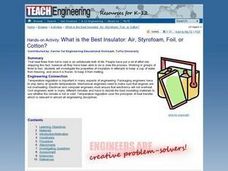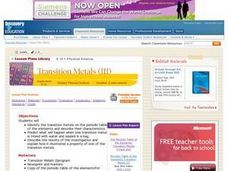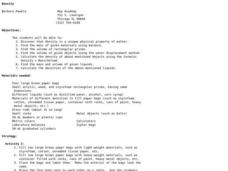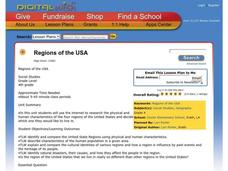Curated OER
What is the Best Insulator: Air, Styrofoam, Foil, or Cotton?
Students investigate the properties of insulators by attempting to keep a cup of water from freezing, and once it is frozen, to keep it from melting. They conduct the experiment, record and analyze the results, and answer discussion...
Curated OER
Cross-Linked Polymer Lab
In this polymer worksheet, learners make two types of cross linked polymers and they test their physical properties. These include their response to agitation, stretchability, viscosity, and resilience.
Curated OER
Cross-Linked Polymer Lab
High schoolers use short-chain polymers and borate ions to produce cross-linked polymers in the lab. In this cross-linked polymer lesson plan, students produce polyvinyl acetate slime and polyvinyl alcohol slime and test their physical...
Curated OER
Characteristics of Matter
Students study matter. In this science lesson plan, students examine the relationships among gravity, weight, and mass, the metric measurement of distance and volume, and density and its application to physical properties.
Curated OER
Snack Attack: Food Packaging Activity
Students design and create packaging material for food. In this snack attack lesson, students design a package to protect a food item from heat and water. Students consider costs of materials, design, and test the package to see if it is...
Curated OER
Sink or Float?
Students will determine whether various objects sink or float in water. They do not need to explain why objects sink or float. They are rather to be encouraged to observe that the same objects will sink or float every time, i.e., that...
Curated OER
PV=nRT=Bang!
In this ideal gas law worksheet, students watch a demonstration using liquid nitrogen, a plastic 2 liter bottle and a garbage can of water that excites students to use the ideal gas law to solve problems. Students analyze the results of...
Curated OER
Volume of Gas
Eighth graders investigate the effect of temperature on the volume of a gas in a closed container. They measure the height of the water in their beaker/container, conduct their experiment, and create a graph to illustrate their data.
Curated OER
Transition Metals (III)
Students discuss transition metals, where they are located on the periodic table, some of the element in the group, and some characteristics of the group. They work in groups to conduct an experiment in which they mix transition metals...
Curated OER
Density
Students find the mass, volume, and density of various objects. In this density measurement lesson, students observe how same-sized objects can have different masses, then use water displacement to find the density of each object and...
Curated OER
Regions of the USA
Fourth graders research the physical characteristics of the four regions of the United States. In this geography lesson, 4th graders research the four regions and use a quilt square organizer to record notes. Students complete the quilt...
Curated OER
Transition Metals (II)
High schoolers discuss transition metals, their properties, and where they are located on the periodic table as well as why transition metals are ideal for coins. After discussion, they conduct an experiment using copper in the form of...
Curated OER
Aqua-Thrusters!
Young scholars construct their own rocket-powered boat called an "aqua-thruster." These aqua-thrusters will be made from a film canister and will use carbon dioxide gas - produced from a chemical reaction between an antacid tablet and...
Curated OER
Oxidation and Salt
Students study the reaction on iron in water, air, and sodium chloride. They create a situation that shows this process and gives them the opportunity to hypothesize what, why, and how. They keep records and do an oral and written ...
Curated OER
Somethin' Sweet
Students make their own candy. In this science lesson plan, students observe how molecules interact with each other in physical changes and observe how the addition of heat can cause molecules to interact and form new molecules in...
Curated OER
Egg Fun
Students explore the physical properties of eggs. In this scientific observation lesson plan, students define characteristics of eggs, measure eggs vertically and horizontally, and use the scientific method to perform simple experiments...
Curated OER
Concrete Research
Students explore concrete. In this physical science and computer research lesson, students work in groups to answer specific questions about concrete. Each group of students completes a different worksheet with a specific subtopic....
Curated OER
The Nature of Chemical Change: Acting Out an Example
Students identify the signs that a chemical reaction took place. In this chemistry lesson, students role play the movement of different molecules of matter. They classify matter according to their properties.
Curated OER
Reviving Celery
The classic in-class demonstration using celery dipped into water with food coloring is the highlight of this biology lesson plan. Young scientists discover that organisms are made up cells and have distinguishing characteristics. After...
Curated OER
Ice Cream Blizzards
Fourth graders explore whether the making of homemade ice cream is a physical change or a chemical change in a lab experiment. Students identify states of matter, describe the physical properties of states, and collect temperature data...
Curated OER
Navajo Pottery
In this Navajo pottery worksheet, students conduct an experiment using various samples of earthen material. Students are required to collect at least three samples of dirt. Students can make observations about the texture of the sample...
Curated OER
Strange States of Matter
Fourth graders explore objects that do not fit into the categories given by three states of matter. They explore why an object doesn't fit perfectly into one of the three categories. Students observe the properties of Oobleck. They...
Curated OER
Heat and Temperature
Ninth graders explore the relationship between heat and temperature. After performing experiments, 9th graders record their observations and discuss the results. They investigate the properties of heat and explore how energy possessed...
Cornell University
Unknown Powders
Create a little scientific magic within your classroom! Learners mix powders and liquids and identify chemical reactions. Based on the reactions, individuals determine the identity of various powders.

























